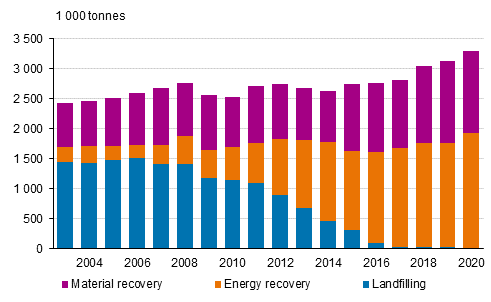Published: 9 December 2021
Amount of municipal waste continued growing in 2020 – most of waste was still recovered as energy
In 2020, around 3.3 million tonnes of municipal waste were generated. Compared with the previous year, the total amount of waste increased by 170,000 tonnes, or by over five per cent. There were no great changes in the mutual shares of waste treatment methods. The amount of waste corresponded to around 596 kg calculated per inhabitant.
A total of 3,296,000 tonnes of municipal waste were generated in 2020. Compared with the previous year, the growth amounted to around 170,000 tonnes, or over five per cent. The growth in the amount of waste has continued for several years in succession. In addition to waste generated in housing, comparable waste from trade, manufacturing and services, such as waste from offices and canteens, is regarded as municipal waste.
Energy recovery is the most common treatment method for municipal waste
No great changes took place between different waste treatment methods. Since 2012, energy recovery of waste has been the most significant treatment mode of municipal waste – in 2020 its share grew slightly, to 58 per cent. Energy recovery of municipal waste is based on combined production of electricity and heat, and heat is particularly recovered in district heating networks.
Municipal waste by treatment method in 2004 to 2020

The share of material recovery of waste decreased slightly, being 42 per cent. On the other hand, its total amount remained on level with before; the growth in the total amount of municipal waste was mainly directed to energy use. In 2020, the already very small proportion of landfill disposal decreased to about half per cent of the total amount of municipal waste.
Especially biowaste and plastic were recycled more than before
Over 1.6 million tonnes of mixed waste were generated in municipalities: the amount grew by just under eight per cent from the previous year. Nearly all mixed waste ended up in energy recovery.
The total amount of waste components collected separately as material grew to 1.5 million tonnes. The volumes of paper and board waste, biowaste and plastic waste recollected grew most from the previous year in absolute numbers. The volume of separately collected paper and board waste increased by just under ten per cent. Part of the data concerning packaging waste are based on an estimate that was compiled from data in 2019. For paper and board packaging, the data are more accurate and the growth in the amount of waste was clear.
Six per cent more biowaste was collected separately than in the previous year. Most of biowaste was composted and decomposed, and the processing of various edible fats into energy fuels has increased. Decomposition produces biogas, in addition to which the decomposition residue and compost soil can be utilised in soil improvement or landscape development.
Of other separately collected waste, most growth was seen in the volume of plastic waste. The data on packaging waste to be supplemented later will specify the amount of treatment, probably increasing plastic waste.
Amount of municipal waste grew to 596 kg per capita
The amount of waste also grew relative to Finland's population. At the beginning of the 2010s, the amount of waste settled at around 500 kg per capita. In 2020, the amount of municipal waste was 596 kg per person, growing by 31 kg from the year before.
Municipal waste generated per capita in 2004 to 2020

Source: Waste statistics 2020, Statistics Finland
Inquiries: Juha Espo 029 551 3463, Heidi Pirtonen 029 551 3583, ymparistotilinpito@stat.fi
Head of Department in charge: Katri Kaaja
Publication in pdf-format (206.0 kB)
- Tables
-
Tables in databases
Pick the data you need into tables, view the data as graphs, or download the data for your use.
Appendix tables
- Appendix table 1. Municipal waste 2020, tonnes (9.12.2021)
Updated 9.12.2021
Official Statistics of Finland (OSF):
Waste statistics [e-publication].
ISSN=2323-5314. Municipal waste 2020. Helsinki: Statistics Finland [referred: 18.4.2025].
Access method: http://stat.fi/til/jate/2020/13/jate_2020_13_2021-12-09_tie_001_en.html

